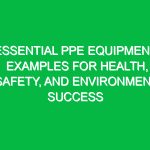Introduction
Good morning, team! Today, we’re gathering for our Toolbox Talk to address a crucial aspect of our daily operations: falls Prevention. Falls are one of the leading causes of workplace injuries, and it’s our responsibility to understand how to prevent them. This talk will cover essential tips and Best Practices that you can apply every day to ensure not only your Safety but also that of your colleagues. Let’s dive into the world of Safety falls prevention.
Understanding Falls in the Workplace
Falls can happen anywhere—whether you’re working on a construction site, in a warehouse, or even in an office Environment. According to the Occupational Safety and Health Administration (OSHA), falls account for a significant number of fatalities and injuries in various industries. Understanding the types of falls and their causes is the first step toward prevention.
Types of Falls
- Same-level falls: These occur when a person slips or trips on the same surface they are walking on. Common causes include wet floors, uneven surfaces, and cluttered walkways.
- Elevation falls: These happen when a person falls from a height, such as ladders, scaffolding, or rooftops. These incidents can lead to serious injuries or fatalities.
- Fall Hazards: These are any conditions or situations that increase the risk of falling, such as poor lighting, lack of guardrails, or unprotected edges.
The Importance of Falls Prevention
Preventing falls is not just about compliance; it’s about safeguarding lives. Each one of you plays a vital role in fostering a culture of safety. By identifying Hazards and adhering to safety protocols, we can minimize the risk of falls and create a safer working environment. Remember, a safe workplace is a productive workplace.
Real-life Example
Let’s consider a scenario. Imagine a co-worker, Sarah, who was working on a ladder to reach a high shelf. She was in a hurry and neglected to secure the ladder properly. As she reached for a box, the ladder wobbled, and she fell. Fortunately, she only sustained minor injuries. However, this incident could have been avoided if proper Safety Measures had been followed, such as ensuring the ladder was stable and using a spotter.
Key Safety Practices to Prevent Falls
Now that we understand the types of falls and their importance, let’s discuss some practical safety practices that can significantly reduce the risk of falls.
1. Conduct Regular Inspections
Before starting any job, conduct a thorough inspection of your work area. Look for potential hazards such as wet floors, loose cables, or uneven surfaces. Addressing these issues proactively can prevent slips and trips.
2. Use Proper Equipment
Always use equipment designed for the task at hand. If you’re working at heights, ensure you’re using the right ladder or scaffold and that it’s set up correctly. Make sure to inspect your Personal Protective Equipment (PPE) regularly, ensuring it’s in good condition.
3. Maintain Clean Workspaces
A tidy workspace can significantly reduce the chance of accidents. Ensure that walkways are clear of clutter and spills are cleaned promptly. Encourage your colleagues to maintain cleanliness as well.
4. Use Handrails and Guardrails
Handrails and guardrails are essential safety features that can prevent falls. Always ensure they are in place and properly maintained. If you notice damaged railings, report them immediately.
5. Employ Safe Lifting Techniques
When lifting objects, always bend at your knees and keep your back straight. If an object is too heavy, ask for help or use mechanical aids. This practice not only prevents falls but also reduces the risk of back injuries.
6. Stay Aware of Your Surroundings
Being aware of your environment is crucial. Always keep an eye out for potential hazards and remain focused on your tasks. Avoid distractions that could lead to accidents, such as using your phone while walking.
Training and Awareness
Continual Training and awareness are vital components of falls prevention. Regularly participate in safety training sessions to stay updated on Best Practices and Regulations. Share your experiences and tips with your colleagues during Toolbox Talks or safety meetings.
Engagement and Discussion
Let’s take a moment to discuss. Can anyone share a time when they encountered a potential fall hazard? How did you handle it? What could have been done differently? Sharing experiences can help us learn and improve our safety practices.
Relevant Regulations and Standards
Compliance with safety regulations is crucial for preventing falls. osha has established standards specifically addressing Fall Protection in various industries. Familiarize yourself with these regulations and ensure that our workplace policies align with them.
Impact of Compliance
Adhering to safety regulations not only protects you and your colleagues but also shields our company from legal liabilities. Non-compliance can lead to fines and increased insurance premiums, which can negatively impact our operations.
Conclusion
In conclusion, falls prevention is a shared responsibility that requires diligence and awareness from all team members. By implementing the practices we discussed today, you will contribute to a safer workplace. Remember, safety is not just a priority; it’s a value we uphold. Thank you for your attention and commitment to making our work environment secure. Together, let’s continue to foster a culture of safety and prevent falls in all our operations.


